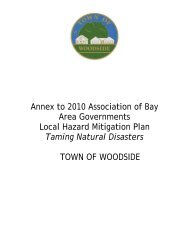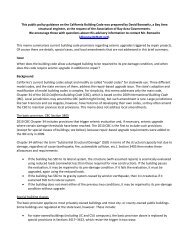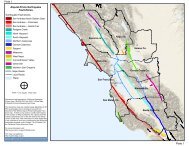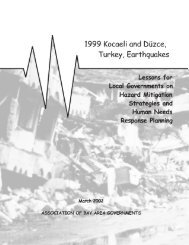Airport Liquefaction Susceptibility Analysis Report - ABAG ...
Airport Liquefaction Susceptibility Analysis Report - ABAG ...
Airport Liquefaction Susceptibility Analysis Report - ABAG ...
Create successful ePaper yourself
Turn your PDF publications into a flip-book with our unique Google optimized e-Paper software.
Fugro Consultants, Inc.<br />
Project No. 04.79221200<br />
The recency of the Arroyo Mocho deposits is indicated by the presence of fresh distributary<br />
channels, mapped in blue dots on Figure 6C.<br />
Site development began in the early 1960s and airport construction was completed in<br />
December 1965. The new airport encompassed 257 acres, a 4,000-foot asphalt runway with a<br />
parallel taxiway, an aircraft parking apron with 100 tie-downs, a beacon, a lighted wind cone and<br />
segmented circle, and 50 based aircraft. Additional structures were built on the site in 1970,<br />
1973, and 1979, 1985, and 1987. A second 2,699-foot parallel runway was built in 1985 and an<br />
extension of the main runway to 5,255 feet followed in 1989. Today, the Livermore Municipal<br />
<strong>Airport</strong> encompasses 644 acres (City of Livermore, 2013). A recent aerial photograph (Figure<br />
6D) shows the airport in its present urban setting.<br />
Borehole data indicate that artificial fill at the airport is present on the western 3/4 of the property<br />
and ranges in thickness from 4.5 to 10 feet, thickening westward or downslope (Figure 6B;<br />
Cornerstone Earth Group, 2010). Due to the limits of data, it is possible (but unlikely) that fill<br />
extends below depths of 10 feet. No significant fill thickness is found at the upslope, or eastern,<br />
end of the property. The fill can be subdivided into two distinct units (Fill A and Fill B). Fill A<br />
generally consists of very stiff to hard lean clay with fine sand. Fill B generally consists of<br />
medium dense, clayey, fine to coarse sand with fine to coarse gravel.<br />
Underlying the artificial fill are Holocene medial and distal alluvial fans deposits. These deposits<br />
consist of lean clay with sand, sandy lean clay, sandy silty clay, and silty clay interbedded with<br />
silty sand, clayey sand, and poorly graded sand with gravel (CGS, 2008).<br />
4.5 Moffett Federal Airfield (NUQ)<br />
Moffett Federal Airfield is located at the southern margin of San Francisco Bay in Santa Clara<br />
County. The airport is built over Holocene fine-grained alluvial fan deposits (Qhff) and Holocene<br />
estuarine deposits or Bay Mud (Qhbm; Figure 7A). Most of the airport property is located on the<br />
distal end of the Stevens Creek alluvial fan, derived from the Santa Cruz Mountains to the south<br />
of the site. Maps of the historical extent of bay environments based on 1800s US Coast Survey<br />
mapping, show that the north end of the airport property encompasses former tidal marsh and<br />
salt panne environments (Figure 7B; SFEI, 2000). The estuarine deposits are collectively<br />
referred to as San Francisco Bay Mud (Qhbm) on Figure 7A and Young Bay Mud (YBM) on<br />
Figure 7C.<br />
Aerial photography taken in 1939 (Figure 7D) shows the airport property before construction of<br />
the runways. Some facilities, including Hangar One, are already in place. The historical bay<br />
shoreline shown in Figure 7B is still visible, running parallel to an east-west dike that separates<br />
the uplands from the tidal marsh lands. The grasslands on which the airport runways are to be<br />
built are visible in the photograph. Topographic contours from the USGS Mountain View 7.5-<br />
minute quadrangle (1991) show a northward sloping alluvial fan surface, decreasing in gradient<br />
as it approaches the estuary. The airport is on the gently sloping north end of this alluvial fan.<br />
13<br />
May 31, 2013








